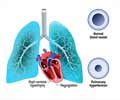Use of medications with temporary use of an artificial heart pump, known as a left ventricular assist device (LVAD), could help certain patients with heart failure live longer, healthier, and more productive lives.

‘LVAD combined with standardized medication and regular cardiovascular checkups could be a feasible substitute for transplantation for heart failure patients.’
Read More..




"For decades, heart transplantation and LVADs have been the therapeutic cornerstones of advanced heart failure," says Stavros Drakos, M.D., PhD, co-corresponding author of the study, cardiologist and director of Cardiovascular Research for the U of U Health Division of Cardiology.Read More..
"But this alternative approach is different. It appears to be a bridge to heart recovery without requiring transplantation or long-term use of an artificial heart pump."
The study, which was conducted at six specialized medical centers nationwide, appears in Circulation, an American Heart Association journal.
What hadn't been appreciated until relatively recently is that LVADs significantly reduce the strain on failing hearts. In some cases, using LVADs for limited periods of time has allowed hearts to "rest" and remodel their damaged structures. As a result of these repairs, described as "reverse remodeling," heart function improves to the point that the LVAD can be removed.
In initial trials, researchers developed a treatment that combines LVAD uses with standard heart failure drugs known to enhance repair of heart tissue. The treatment appeared to be successful, with several patients surviving more than three years after their LVADs were removed.
Advertisement
The researchers recruited 40 advanced heart failure patients between the ages of 18 to 59 who were so severely ill that they required surgical implantation of a LVAD pump to remain alive.
Advertisement
These improvements included successfully completing a six-minute treadmill test and having sustained blood flow and blood pressure with the LVAD at low pump settings.
Following up, the researchers found that 90% of these patients were still alive one year after the removal of the LVAD, while 77% survived and were doing very well at two and three years of follow up. This rate of recovery is significantly higher than expected for this stage of the heart failure disease.
The research team concluded that this strategy of LVAD support combined with standardized medication and regular cardiovascular checkups led to high rates of LVAD removal, demonstrating it as a feasible substitute for transplantation or lifelong LVAD use. LVADs are physically burdensome and can be a source of complications, while heart transplants are difficult to come by.
"People that look at heart disease are usually trying to figure out why a heart is becoming worse," says Craig Selzman, M.D., a study co-author and chief of U of U Health's Division of Cardiothoracic Surgery. "This research is important because it's an alternative approach that is trying to figure out why these failing hearts are actually getting better."
The study had limitations, including a small number of patients, a lack of a control group, and a focus on patients younger than 60 years old. However, the researchers note that this does not necessarily mean that older patients and those who have varying degrees of heart failure would not benefit from this treatment.
Moving forward, the U of U Health researchers in conjunction with others plan to continue exploring how and why this treatment works. In particular, they have been focused on the metabolic pathways in the heart. Based on recent findings the team also published in Circulation, Drakos says these pathways appear to play a key role in the restructuring and remodeling that occurs.
"This multi-center study builds on and validates more than a decade of research conducted by Utah physician-scientists in this exciting field of heart recovery," Drakos says. "We are invested in figuring how to help a failing heart recover its function with just a little help from us."
Source-Eurekalert












